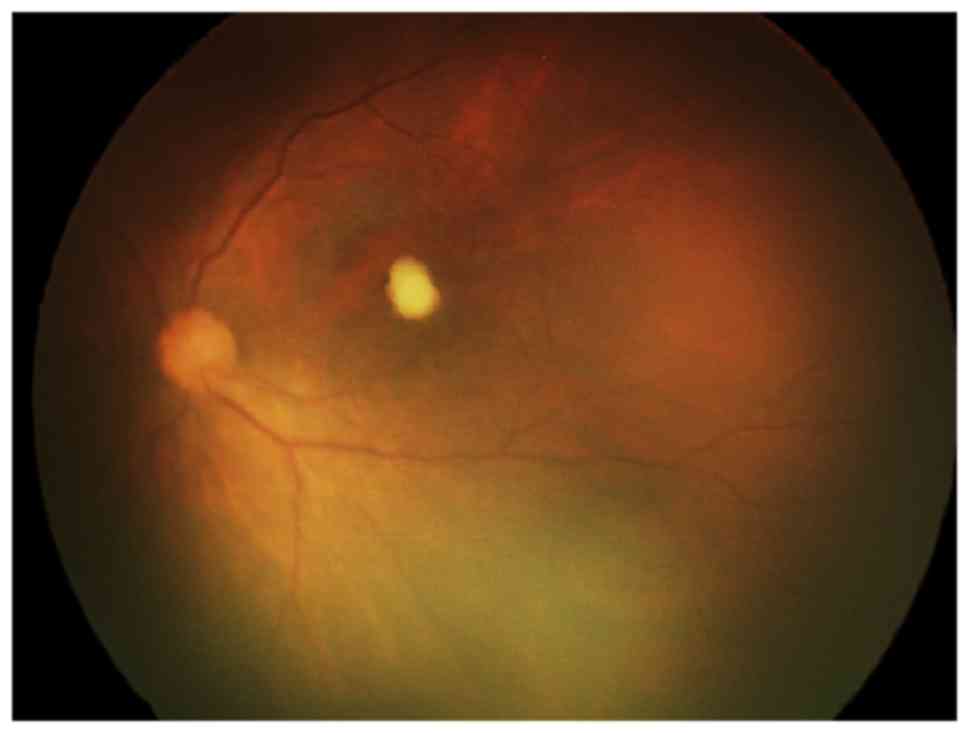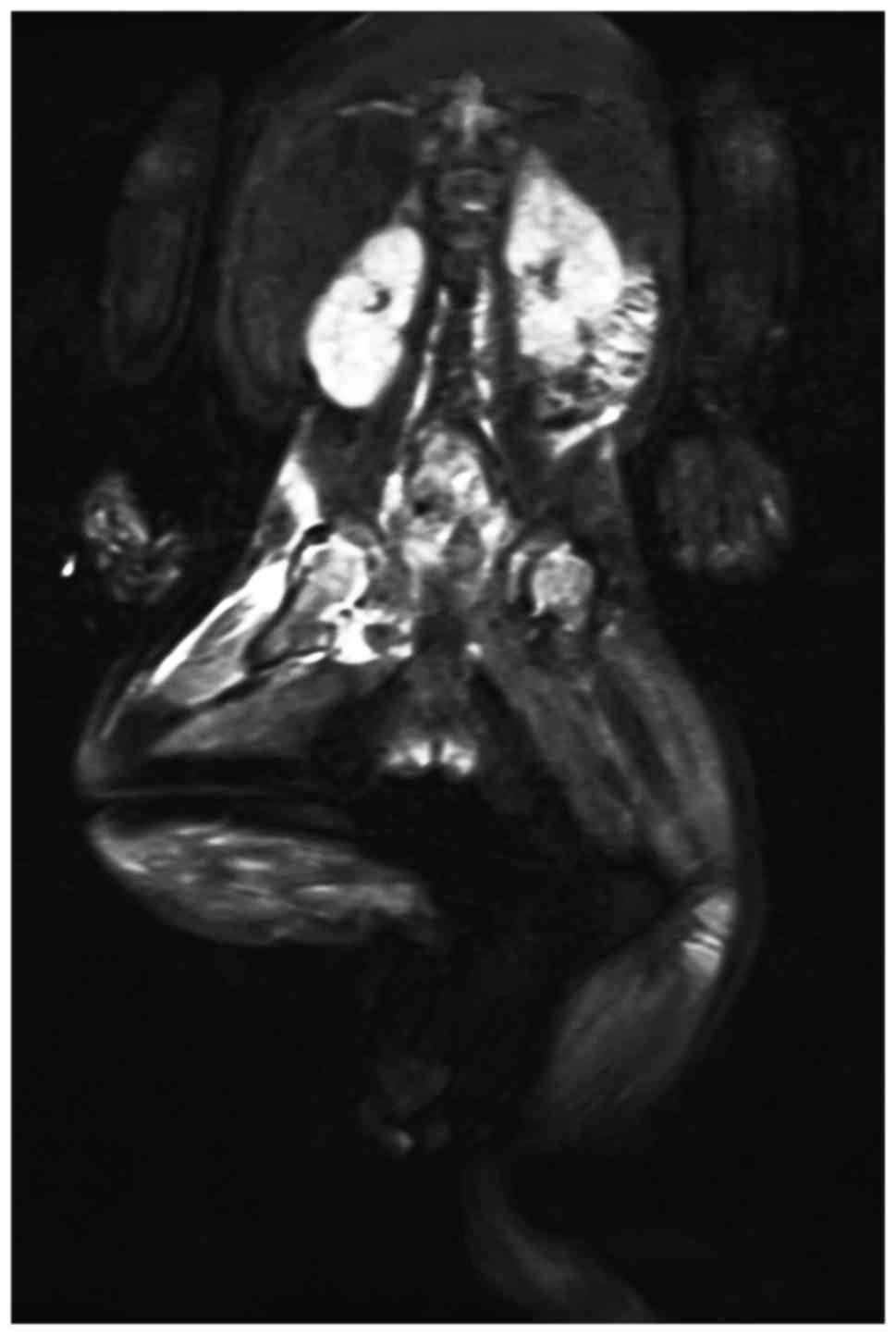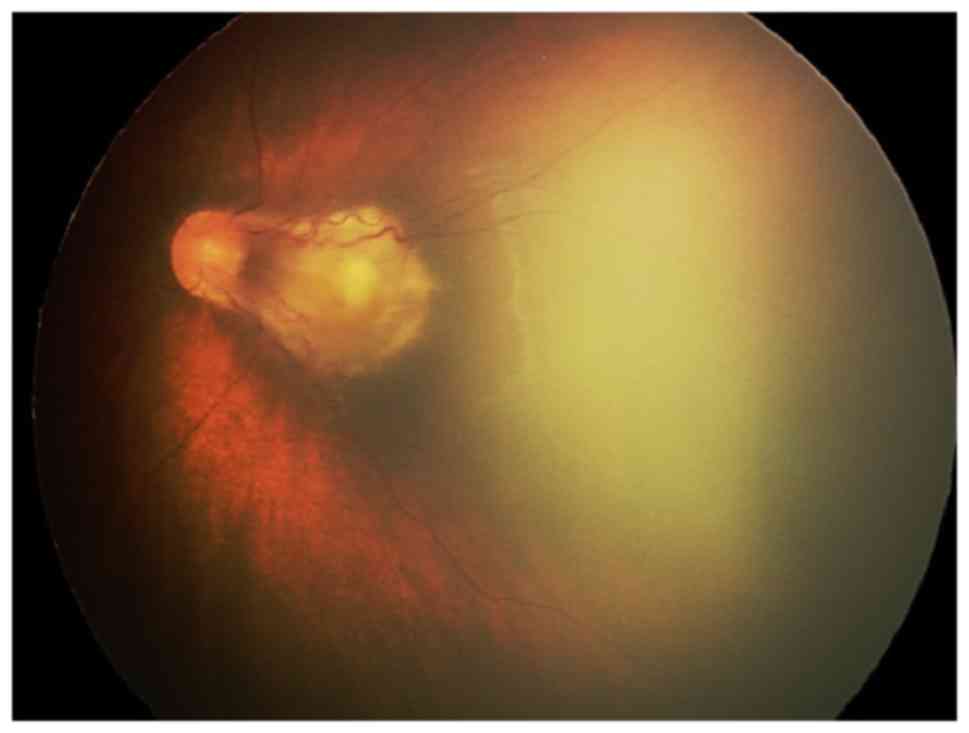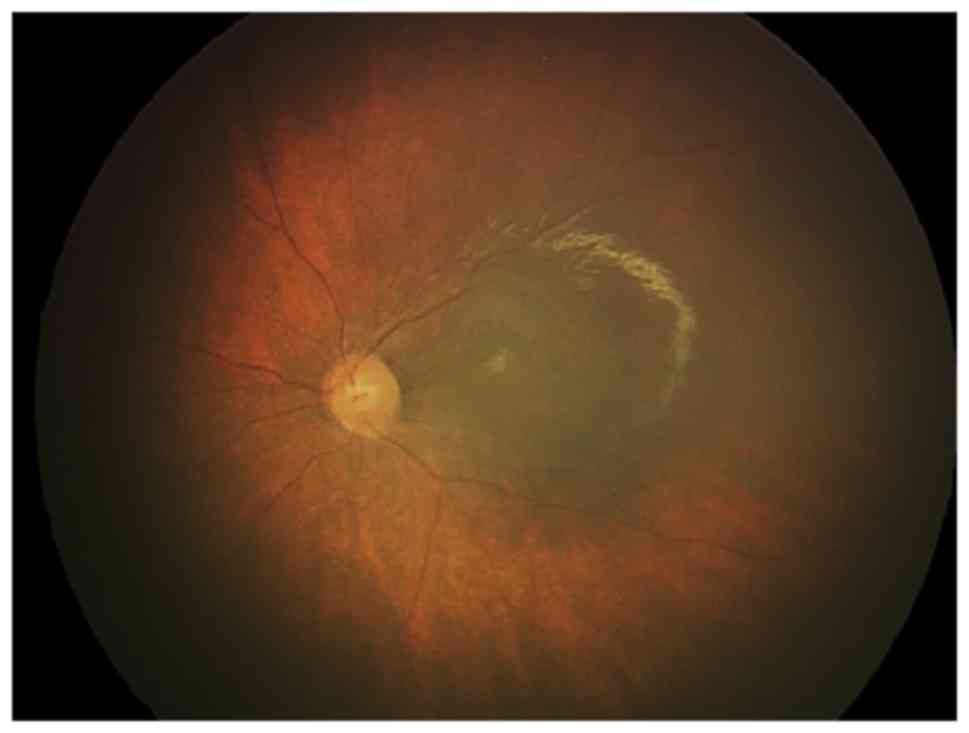Fungal chorioretinitis with systemic candidiasis in an infant following treatment with broad spectrum antibiotics: A case report
- Authors:
- Published online on: May 23, 2017 https://doi.org/10.3892/etm.2017.4507
- Pages: 286-288
-
Copyright: © Lu et al. This is an open access article distributed under the terms of Creative Commons Attribution License.
Abstract
Introduction
Endogenous fungal chorioretinitis in newborn infants is a rare condition that may lead to vision loss (1). To the best of our knowledge, a Candida infection disseminating from the eye to the hip joint in infants has not been previously reported. Early diagnosis and aggressive treatment are essential to avoid vision loss. Ocular candidiasis is a serious complication of candidemia, but little information has been published on the optimal duration of treatment. Based mainly on expert opinion, the Infectious Diseases Society of America guidelines propose 4–6 weeks of treatment for endophthalmitis with the duration being determined by the stabilization or resolution of eye lesions (2). The current case report describes a case of successfully treated fungal chorioretinitis and hip osteoarthritis with systemic candidiasis, in a full term infant following treatment with antibiotics.
Case report
A 39-week-gestation female infant was delivered by caesarean section at The First Hospital of Jilin University (Changchun, China) in September 2014. At day 6 postpartum, the patient became febrile, with a temperature of 39°C and experienced vomiting. The patient was diagnosed with septicemia and neonatal meningitis. Following intravenous administration of cefepime (30 mg/kg) twice a day for 11 days, a prominent conjunctival infection developed in the left eye. Cultures for Candida albicans in the blood and cerebrospinal fluid tested positive. Other tests include blood tests [white blood cells 0.9×109/l (neutrophils 0.216×109/l, lymphocytes 0.684×109/l), red blood cells 5.25×1012/l, hemoglobin 189 g/l, platelet 279×109/l] and cerebrospinal fluid tests [Cl 121 mmol/l, Glu 0.8 mmol/l, protein 1.0 g/l, Pandy's test (−), white blood cells 20×106/l (macropolycytes 8×106/l, monocytes 12×106/l), red blood cells 70×106/l]. Ophthalmic examination indicated one yellow-white chorioretinal juxta foveal lesion in the left eye, with neither vitreous haze nor cells (Fig. 1). Chest X-ray and tuberculin skin test were normal. Intravenous fluconazole (6 mg/kg daily; Lunan Pharmaceutical Group Co., Ltd., Linyi, China) administration was begun instead of cefepime for the treatment of fungal infection. The patient stopped vomiting and the temperature was 36.8°C following the use of fluconazole for 20 days. Cultures for Candida albicans in the blood and cerebrospinal fluid tested negative. Subsequently, the patient was discharged.
However, 6 days after discharge, the patient was referred to The First hospital of Jilin University with a 1-day history of fever and limitation of motion in the right hip. A diagnosis of hip osteoarthritis was established by magnetic resonance imaging (Fig. 2). Fundus examination indicated that the lesion had expanded and extended to the inferior and superior temporal vascular arcades in the left eye (Fig. 3). Following a further 4 weeks of intravenous fluconazole administration (6 mg/kg daily), no active chorioretinal lesions were observed in the fundus examination (Fig. 4) and limitation of motion in the right hip was completely resolved. The blood culture for C. albicans was negative. Three months later, the patient remained asymptomatic and fundus examination was unremarkable.
Discussion
Fungal chorioretinitis is defined as the presence of deep, focal, white chorioretinal lesions with no evidence of direct vitreous involvement (3) and it is rarely diagnosed in newborn infants due to high availability of prophylactic antifungal therapy (1). Those at risk of developing fungal chorioretinitis include hospitalized patients with a history of a compromised immune system, diabetes mellitus, intravenous drug use, chronic use of indwelling catheters, use of broad spectrum intravenous antibiotics or hyperalimentation (4,5). The risk factor for the patient in the current study was treatment with broad spectrum antibiotics.
The most common causative species of candidemia identified in fungal culture is C. albicans (41%), followed by Candida parapsilosis (24%) and Candida glabrata (13%). The most common organ of dissemination is the lung (58%), followed by the liver (23%), kidney (16%), brain (12%), spleen (8%), heart (8%) and eye (8%) (4). The probability of fungus disseminating to a given organ seems be correlated with the relative size and blood supply of that organ (6). Of 38 heroin users treated for systemic Candida infections, 10 had osteoarticular involvement (vertebrae, costal cartilage, knees and sacroiliac) (7). To the best of our knowledge, this is the first report of Candida infection disseminating from the eye to hip joint in an infant. Ophthalmologists should be aware of this unusual complication when treating active Candida chorioretinitis.
When treating patients with fungal chorioretinitis, there is some debate over the appropriate duration of systemic antifungal therapy. According to the most updated guidelines, the duration of therapy for fungal chorioretinitis should be at least four to six weeks and should ideally continue until all clinical evidence of intraocular infection has been resolved (2). The current case is consistent with these guidelines, supporting the proposal that four weeks of antifungal treatment is necessary. Although the occurrence of ocular infection is very low in newborns, close follow-up of infants who survive fungemia remains essential, as in a minority of cases, preterm infants with successfully treated fungemia may develop a fungal abscess in the crystalline lens, as a result of Candida sequestration (8).
In conclusion, in cases of fungal chorioretinitis, early detection and rational duration of treatment using fluconazole or other systemic antifungals may prevent severe ocular involvement and avoid lifelong visual impairment. Particular care should be taken to test for fungal chorioretinitis in the presence of risk factors or external signs of intraocular inflammation (3,9,10). To the best of our knowledge, this is the first reported case of a Candida infection disseminating from the eye to the hip joint in an infant. The patient was successfully treated with fluconazole, and the current results suggest that at least four to six weeks of antifungal treatment should be administered in future cases.
References
|
Dozier CC, Tarantola RM, Jiramongkolchai K and Donahue SP: Fungal eye disease at a tertiary care center: The utility of routine inpatient consultation. Ophthalmology. 118:1671–1676. 2011. View Article : Google Scholar : PubMed/NCBI | |
|
Pappas PG, Kauffman CA, Andes D, Benjamin DK Jr, Calandra TF, Edwards JE Jr, Filler SG, Fisher JF, Kullberg BJ, Ostrosky-Zeichner L, et al: Clinical practice guidelines for the management of candidiasis: 2009 update by the infectious diseases society of America. Clin Infect Dis. 48:503–535. 2009. View Article : Google Scholar : PubMed/NCBI | |
|
Donahue SP, Greven CM, Zuravleff JJ, Eller AW, Nguyen MH, Peacock JE Jr, Wagener MW and Yu VL: Intraocular candidiasis in patients with candidemia. Clinical implications derived from a prospective multicenter study. Ophthalmology. 101:1302–1309. 1994. View Article : Google Scholar : PubMed/NCBI | |
|
Fraser VJ, Jones M, Dunkel J, Storfer S, Medoff G and Dunagan WC: Candidemia in a tertiary care hospital: Epidemiology, risk factors, and predictors of mortality. Clin Infect Dis. 15:414–421. 1992. View Article : Google Scholar : PubMed/NCBI | |
|
Tanaka M, Kobayashi Y, Takebayashi H, Kiyokawa M and Qiu H: Analysis of predisposing clinical and laboratory findings for the development of endogenous fungal endophthalmitis. A retrospective 12-year study of 79 eyes of 46 patients. Retina. 21:203–209. 2001. View Article : Google Scholar : PubMed/NCBI | |
|
Zaoutis TE, Greves HM, Lautenbach E, Bilker WB and Coffin SE: Risk factors for disseminated candidiasis in children with candidemia. Pediatr Infect Dis J. 23:635–641. 2004. View Article : Google Scholar : PubMed/NCBI | |
|
Dupont B and Drouhet E: Cutaneous, ocular, and osteoarticular candidiasis in heroin addicts: New clinical and therapeutic aspects in 38 patients. J Infect Dis. 152:577–591. 1985. View Article : Google Scholar : PubMed/NCBI | |
|
Donahue SP, Hein E and Sinatra RB: Ocular involvement in children with candidemia. Am J Ophthalmol. 135:886–887. 2003. View Article : Google Scholar : PubMed/NCBI | |
|
Brod RD, Flynn HW Jr, Clarkson JG, Pflugfelder SC, Culbertson WW and Miller D: Endogenous Candida endophthalmitis. Management without intravenous amphotericin B. Ophthalmology. 97:666–674. 1990. View Article : Google Scholar : PubMed/NCBI | |
|
Dellon AL, Stark WJ and Chetien PB: Spontaneous resolution of endogenous Candida endophthalmitis complicating intravenous hyperalimentation. Am J Ophthalmol. 79:648–654. 1975. View Article : Google Scholar : PubMed/NCBI |













